|
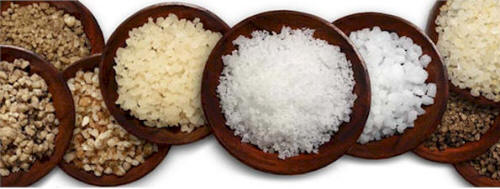

Introduction
In July of 2002 I wrote an article called
All About Salt in which I stated that "the only difference between ordinary table salt and gourmet sea salt is the price" and "What it boils down to is this: salt is salt. ... Regardless of where it came from or how it is processed, salt is always salt." These statements caused quite a bit of controversy at the time of their original publication and have continued to provoke nasty remarks since then, owing to the article's more-or-less continuous presence on the World Wide Web. (If you do a Google search for "all about salt" you will probably find my website among the top results.)
In early May of 2012, after a particularly rancorous exchange of emails with some guy who took issue with those remarks (and who, by the way, was also in the business of selling "Fleur de Sel Caramels" at ridiculous prices-go figure), I decided it was time to prove my assertions once and for all. Thus was conceived The Great Salt Taste Test.
If my contention that all salts taste the same is proven to be wrong, I will make a public admission of my error like a man. Then I will withdraw completely from society and live the rest of my days alone, pale and blinking, in a dark cave somewhere. If, on the other hand, a carefully controlled blind taste test performed by a large number of volunteer subjects supports my hypothesis, then I will jump up and down, whooping and hollering like a ten-year-old boy, and you'll never hear the end of it.
Let the experiment begin!
Objective
To determine whether people can distinguish between various salts, at a concentration comparable to many common foods, in a controlled blind taste test.
Hypothesis
I think I have already made my opinion on the subject pretty clear, but let me state it for the record anyway: all salts taste the same.
Stated differently, I believe that this experiment will demonstrate that people do not have a preference for expensive salts over ordinary table salt. It's all a matter of some pretty simple arithmetic. Let me explain.
In order to be sold as salt for human consumption in the United States, the U.S. Food and Drug Administration requires that it be at least 97.5% (by weight) pure sodium chloride. That means that everything else that the salt is made of (which I will henceforth refer to as "other stuff") can be, by law, no more than 2.5% of the total weight. That's Fact #1-please remember it.
Fact #2 is that most foods we eat contain no more than about 1% salt by weight because anything above that is deemed too salty by most people (see the procedure section below).
So all the other stuff, the chemical compounds that the purveyors of expensive salts insist provide the unique flavor of their salt, only amounts to 0.025% of the foods we eat under normal circumstances (Fact #1 multiplied by Fact #2, or for the mathematically skeptical, 0.025 x 0.01 = 0.00025). In other words, it's only 2.5 parts per 10,000, or 250 parts per million. That's a very small amount.
Think of it this way: 2.5 parts of other stuff (by weight) per 10,000 parts water is the equivalent of about ½ teaspoon in 10 liters (a little over 2½ gallons). There are very few things that the human sense of taste can detect in such small concentrations, and I am pretty sure that the various compounds of magnesium, potassium, calcium, and other elements that constitute the other stuff in salt are not among them. We can't even detect table salt at that concentration (go ahead and try it if you don't believe me), so why would we be able to taste the other stuff?
Therefore, the only thing we taste in salt is the sodium chloride, and that's why all salts taste the same.
Equipment
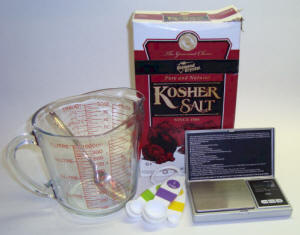
To determine the appropriate level of salinity for the test samples (see Procedure - Step 1 below) I used several items that I had on hand. These included a glass measuring cup, a silver teaspoon to stir the water, a plastic measuring spoon, and my jeweler's scale. The salt I used for this portion of the experiment was the Diamond Crystal kosher salt that I use for everyday cooking.
The scale I used to weigh the salt in all phases of the experiment is a model AMW-100 Precision Pocket Scale manufactured by American Weigh Scales. It has a maximum capacity of 100 grams and is rated at 0.01 gram precision. It was calibrated immediately prior to the start of the experiment using a 100-gram weight I purchased for that purpose.
 For Step 2 of the experiment, in which I prepared the test samples, I purchased some laboratory equipment to ensure precise measuring. These items included a 1000-ml glass beaker and a glass stirring rod. (The non-reactive nature of the beaker and stirring rod will also prevent contamination of the samples.) I also bought 350 60-ml bottles made of food-grade PET plastic for the test samples, and 50 100-ml food-grade PET plastic bottles for the control samples. I used a 60-ml plastic syringe to transfer the samples from the beaker to the bottles. For Step 2 of the experiment, in which I prepared the test samples, I purchased some laboratory equipment to ensure precise measuring. These items included a 1000-ml glass beaker and a glass stirring rod. (The non-reactive nature of the beaker and stirring rod will also prevent contamination of the samples.) I also bought 350 60-ml bottles made of food-grade PET plastic for the test samples, and 50 100-ml food-grade PET plastic bottles for the control samples. I used a 60-ml plastic syringe to transfer the samples from the beaker to the bottles.
 The remaining supplies for the experiment include eight samples of salt from eight different manufacturers, and six gallons of distilled water from my supermarket. The test instructions were printed on some 4x6-inch cards, and the testers will use the same cards to record their test results and return them to me in envelopes I provide. I used Avery 1-inch round labels to clearly identify the test and control sample bottles. The United States Postal Service was kind enough to provide 50 Small Flat Rate Priority Mail boxes (at no charge) for shipping the samples to the testers. The remaining supplies for the experiment include eight samples of salt from eight different manufacturers, and six gallons of distilled water from my supermarket. The test instructions were printed on some 4x6-inch cards, and the testers will use the same cards to record their test results and return them to me in envelopes I provide. I used Avery 1-inch round labels to clearly identify the test and control sample bottles. The United States Postal Service was kind enough to provide 50 Small Flat Rate Priority Mail boxes (at no charge) for shipping the samples to the testers.
Procedure
Step 1 - In order to ensure that the testers would be able to judge the taste of the salts without being influenced by the color, size, or texture of the salt crystals, I decided that the salt samples in this experiment would be dissolved in water at a concentration that would be similar to the concentration found in many common foods. After all, this is The Great Salt Taste Test, not the Great Salt Texture Test, right? The first thing I had to determine was an appropriate level of salinity, so I devised an experiment that Goldilocks would have been proud of.
I measured 1 liter of water in my large kitchen measuring cup, and then dissolved 1 teaspoon of kosher salt in the water. I tasted it and found that it wasn't salty enough-the salt was barely perceptible. I dissolved another teaspoon of salt and tasted it. This ratio of 2 teaspoons per liter of water was pleasantly salty. Then I added another teaspoon of salt, tasted again, and found it to be too salty. If I had been served a bowl of soup in a restaurant that was that salty, I would have sent it back to the kitchen. My laboratory assistant (who goes by the name of Mom around here) also tasted the different solutions and concurred with my findings. Thanks, Mom.
I decided that 2 teaspoons of salt per liter of water was a suitable analog for many everyday foods (think of it as chicken soup without the chicken) and that it was "just right" for this experiment. However, I know that measuring salt by volume is notoriously inaccurate due to the different sizes and shapes of salt crystals, and that a teaspoon of salt can weigh from about 2.5 to more than 6 grams. (The salts used in this experiment range from 2.8 to 6 grams per teaspoon according to the nutrition facts on the labels.) The only way to make sure that all of the samples of salty water were of the same concentration would be to measure the salts by weight, so I weighed 2 teaspoons of the same kosher salt on my jeweler's scale and found that it weighed 10.1 grams.
Thanks to the elegant simplicity of the metric system in which units of weight are defined by volumes of water, 1 liter of water at standard temperature and pressure weighs, by definition, exactly 1,000 grams. Conveniently, 10 grams of salt per 1,000 grams of water provides a concentration of exactly 1%. I thought this was the kind of number I might be able to remember without having to constantly consult my notes, so I decided to use this proportion to make all of the samples of salty water to be used in the experiment.
Update - June 15, 2012 - I realized that many people probably don't share my preference for lightly salted foods. I also wanted the samples to have a more pronounced taste of salt in order to give the testers more to work with in terms of flavor, so I decided to increase the concentration of the salt in the samples. I mixed batches of salt water at concentrations of 1% (the same as before, for comparison) and 1.1%, 1.2%, and 1.3%. Although they all tasted very similar, my laboratory assistant and I agreed that the 1.2% sample (that's 12 grams of salt dissolved in 1 liter of water) was still pleasantly salty and more analogous to canned soup than the 1% sample. Therefore it was decided that the test samples and control sample would all be prepared at a concentration of 1.2%. I sure hope I don't forget to write that down somewhere.
Step 2 - 350 small (60 ml) bottles made of food-grade PET plastic were labeled A, B, C, D, E, F, and G in quantities of 50 each. The 50 larger (100 ml) food-grade PET bottles were labeled "Control." 12 grams of each salt was added to 1000 ml of distilled water at room temperature in the glass beaker and stirred with the glass rod until completely dissolved. The resulting solutions were transferred to the plastic bottles using the plastic syringe. This procedure was repeated for each salt sample until 50 bottles were filled with approximately 50 ml (for the test samples) or 100 ml (for the control samples) of the solutions.
One bottle of each of the seven test samples and a bottle of the control sample were placed in 50 gallon-size plastic zipper bags, and these were placed in 50 Small Flat Rate Priority Mail boxes which were subsequently labeled and shipped over a period of several days, beginning June 20, 2012. Also included in each box was a 5 ½ x 8 ½-inch note card with printed instructions and a grid for recording the test results (see below) along with an addressed envelope to be used to mail the test results to me. Each card was identified by a control number for tracking purposes.
Step 3 - I received a total of 46 of the 50 score cards that I sent out, yielding a response rate of 92 percent.
I had asked the tasters to compare each test sample to the control sample and to score them based on whether they liked the test sample more than the control or less than the control. The tasters were given a third option of "No opinion" if they liked them equally, or if they couldn't detect a difference between the test sample and the control (see above).
Upon receipt of the score cards from the tasters, the individual scores for each test sample were entered into an Excel spreadsheet. If a test sample was liked more than the control, it was given a numerical value of +1. If a test sample was liked less than the control, it was assigned a value of -1. If the test sample was scored "no opinion," it was assigned a value of zero. The 46 ratings for each test sample were then totaled and an overall numerical score was calculated for each of the seven test samples. Using this methodology, the total scores for the test samples should approach zero if my hypothesis is correct and people are not able to "distinguish between various salts, at a concentration comparable to many common foods, in a controlled blind taste test." On the other hand, if any of the test samples score a significant positive or negative score, then my hypothesis will be disproven.
Results
Below is a table describing the salts I chose to be tested in this experiment along with their scores in the taste test. Three of them came from my local supermarket, and the rest were bought online through Amazon.com. They ranged in price from 41¢ to almost $70 per pound. The control salt (the salt the tasters were instructed to compare the other salts to) was pharmaceutical-grade sodium chloride that I chose because it is the closest thing to pure sodium chloride that I was able to find.
|
Sample A
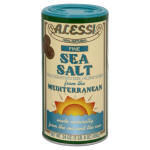
|
Alessi Fine Sea Salt from the Mediterranean
Source: Ingle's Supermarket, Monticello, GA
Price: $2.15 for 24 oz ($1.43 per pound)
Ingredients: None listed on label
Serving size (per label): ¼ TSP (1.2g)
Website: http://www.vigo-alessi.com
This salt dissolved easily and the resulting solution was crystal clear to the naked eye.
Taste test score: 3
11 tasters (23.9%) liked this salt more than the control, 8 tasters (17.4%) liked this salt less than the control, and 27 tasters (58.7%) gave it a "no opinion" rating.
|
|
Sample B
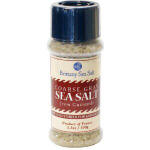
|
Brittany Sea Salt Coarse Gray Sea Salt from Guérande
Source: Amazon.com
Price: $4.75 for 3.3 oz ($23.03 per pound)
Ingredients: Guérande coarse gray salt
Serving size (per label): ¼ TSP (1g)
Website: http://www.brittanysalt.com
This salt dissolved easily and produced a cloudy grey-brown solution resembling sea water. Small bubbles formed on the surface of the water when it was stirred to dissolve the salt. The appearance was unappetizing, and the solution left a "ring" around the beaker at the waterline which persisted after the beaker was rinsed. The beaker had to be cleaned with a soapy sponge in order to remove the residue.
Taste test score: -11
9 tasters (19.5%) liked this salt more than the control, 20 tasters (43.5%) liked this salt less than the control, and 17 tasters (36.9%) gave it a "no opinion" rating. This is the only salt that received a negative rating.
|
|
Sample C

|
Diamond Crystal Kosher Salt
Source: Ingle's Supermarket, Monticello, GA
Price: $0.98 for 13 oz ($1.21 per pound)
Ingredients: Salt
Serving size (per label): ¼ TSP (0.7g)
Website: http://www.diamondcrystalsalt.com
This salt dissolved easily and the resulting solution was crystal clear to the naked eye.
Taste test score: 11
16 tasters (34.8%) liked this salt more than the control, 5 tasters (10.8%) liked this salt less than the control, and 25 tasters (54.3%) gave it a "no opinion" rating. This was the most popular salt. It was also the second least expensive.
|
|
Sample D
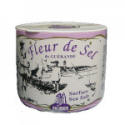
|
Le Paludier Fleur de Sel de Guérande
Source: Amazon.com
Price: $17.95 for 4.4 oz ($65.27 or $69.55 per pound)
Ingredients: Sel marin gris de table
Serving size (per label): None listed
Website: http://www.lepaludier.com
This salt dissolved easily and the resulting solution appeared clear and slightly grey. It was noted that the salt was moist, and the label refers to "exquisite moist granules." I dried 50 grams of the salt by letting it sit in the open air for several days, and the sample weighed 46.92 grams after drying. This represents a water content of 6.16% by weight, and when adjusted to account for the weight of the water, the cost per pound of the salt was actually $69.55. The dried salt was used to prepare the test samples in order to ensure that the amount of salt in the solution was identical for all the salts.
Taste test score: 4
10 tasters (21.7%) liked this salt more than the control, 6 tasters (13.0%) liked this salt less than the control, and 30 tasters (65.2%) gave it a "no opinion" rating.
|
|
Sample E
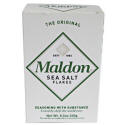
|
Maldon Sea Salt Flakes
Source: Amazon.com
Price: $8.55 for 8.5 oz ($16.09 per pound)
Ingredients: Sea salt flakes with no additives
Serving size (per label): ¼ TSP (1.5g)
Website: http://www.maldonsalt.co.uk
This salt dissolved easily and the resulting solution was crystal clear to the naked eye.
Taste test score: 0
11 tasters (23.9%) liked this salt more than the control, 11 tasters (23.9%) liked this salt less than the control, and 24 tasters (52.2%) gave it a "no opinion" rating.
|
|
Sample F
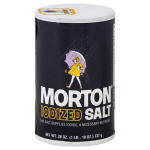
|
Morton Iodized Salt
Source: Ingle's Supermarket, Monticello, GA
Price: $0.67 for 26 oz ($0.41 per pound)
Ingredients: Salt, calcium silicate (an anticaking agent), dextrose, potassium iodide
Serving size (per label): ¼ TSP (1.5g)
Website: http://www.mortonsalt.com
This salt dissolved easily and the resulting solution was cloudy and white in color. This is the only iodized salt in the taste test. It is also the only salt that lists anything other than salt in the ingredients.
Taste test score: 3
14 tasters (30.4%) liked this salt more than the control, 11 tasters (23.9%) liked this salt less than the control, and 21 tasters (45.6%) gave it a "no opinion" rating.
|
|
Sample G
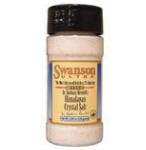
|
Swanson Ultra Himalayan Crystal Salt
Source: Amazon.com
Price: $9.45 for 5.29 oz ($28.58 per pound)
Ingredients: 100% natural Himalayan crystal salt
Serving size (per label): ¼ TSP (1.5g)
Website: http://www.swansonvitamins.com
This salt dissolved easily and the resulting solution was a very pale pink color.
Taste test score: 9
15 tasters (32.6%) liked this salt more than the control, 6 tasters (13.0%) liked this salt less than the control, and 25 tasters (54.3%) gave it a "no opinion" rating. This was the second most popular salt.
|
|
Control

|
CMC Sodium Chloride Tablets U.S.P.
Source: Amazon.com
Price: $11.95 for 3.3 oz ($57.93 per pound)
Ingredients: Sodium chloride USP - Product does not contain any inactive ingredients.
Serving size (per label): Take as directed by your physician.
Website: None
This salt required vigorous stirring to dissolve due to the size of the tablets (1 gram each) and the resulting solution was crystal clear to the naked eye. The actual purity of the salt is not stated on the label, and apparently the U.S.P. (United States Pharmacopeia) designation does not imply a specific degree of purity. I telephoned the manufacturer in Brewster, New York and spoke to Frank Debora, the president of Consolidated Midland Corporation. He stated that the salt was at least 99.9 percent pure sodium chloride, and that it is "the closest thing to pure sodium chloride that you'll find anywhere." Based on these assurances, I believe I am safe in saying that the control sample in this experiment is at least 99.9% pure sodium chloride.
|
Conclusion
Since the objective of this experiment was "to determine whether people can distinguish between various salts, at a concentration comparable to many common foods, in a controlled blind taste test," let's take a look at that first. My expectation was that the taste test scores of the different salts would all be close to zero due to the way I assigned a positive value to those samples that people liked more than the control sample, and the negative value to the samples that people liked less than the control. In other words, I thought the "likes" and the "dislikes" would cancel each other out.
For the majority of the salts, that is exactly what happened … I think. Samples A, D, E, and F all scored a total between zero and 4, and I think those are probably within the margin of error of the sampling method and therefore equivalent to a total of zero. (I could use the help of an expert here, so if anyone out there is a bona fide statistician with verifiable credentials, I sure would like to hear from you.)
Samples B, C, and G don't fall within the same category and even I'm not going to suggest that scores of -11, 11, and 9 fall within the margin of error. People could clearly distinguish these salts from the control sample, and showed a marked preference (samples C and G) or dislike (sample B) when compared to the control sample. There is no denying that some of the tasters could distinguish between some of the salts.
Looking at it from another perspective, 46 tasters each sampled seven salts, producing a total of 322 responses. Of those, 173 responses were "no opinion," indicating that more than half (53.7%) of the samples were indistinguishable from the control sample.
I think that, based on the results of the Great Salt Taste Test, it is fair to say that some people can distinguish between some salts (at a concentration comparable to blah blah blah), and most people cannot distinguish between most salts.
Now, what about the other pronouncements I made in the Hypothesis section above? Let's start with "all salts taste the same." I concede that this is not supported by the results. It appears that most, but not all salts taste the same to most, but not all people. I stand corrected.
And what about my assertion that "people do not have a preference for expensive salts over ordinary table salt"? I think I nailed that one, and as evidence I offer the following three items:
Item 1 - The most popular salt, by a wide margin, was sample C, an ordinary, everyday kosher salt from my local supermarket.
Item 2 - The only salt that the tasters actively disliked was one of the expensive sea salts. The only salt to receive a negative rating (11 more people disliked it than liked it) is also among the most expensive. It was also the salt that received the fewest "no opinion" ratings, showing that more people had an opinion about this salt than any other. (It also looked nasty when I made up the sample batches, but the tasters didn't know that.)
Item 3 - The salt with the most "no opinion" ratings, with a whopping 65.2 percent of the tasters demonstrating indifference, was sample D, the most expensive salt of the bunch. In terms of the number of people who couldn't tell the difference between an expensive sea salt and regular salt, this one was the clear winner.
I won't try to ignore that one salt that was favored by the testers was an expensive sea salt (sample G), but considering that overall the expensive sea salts didn't fare any better than the inexpensive supermarket salts (and bearing in mind the three items I just presented), I'm going to stick my neck out and claim a victory for this statement: people do not have a preference for expensive salts over ordinary table salt.
If you disagree with any of my conclusions, I would love to hear from you.
Discussion
The Wet Finger Method - Several people have written to point out that tasting samples of salty water is very different from tasting the actual salts. For the record, let me state: I couldn't agree more.
Many of the so-called salt taste tests that you'll find on the internet use what I call the wet finger method in which the tasters lick the tip of their finger before dabbing the various salts. It's hard to think of a less precise method, but there you have it. In fact, it's so darned unscientific that I decided to perform a little experiment to demonstrate that comparing salts by the wet finger method produces
meaningless results.
I had ten friends taste two samples of salt by the wet finger method. The salts were contained in identical containers labeled A and B, and I asked them to tell me which one tasted saltier, or if they both tasted the same. Of the ten tasters, six said that A tasted saltier and four said that B tasted saltier. Or was it the other way around? I don't remember.
It doesn't matter which one they thought tasted saltier because both of the samples were the same salt. The fact that not a single taster said they thought the two samples tasted the same proves that the wet finger method is a lousy way to compare salts.
If a taster happened to get more salt on their fingertip when they tasted sample A versus sample B, then it is perfectly understandable that it tasted saltier. This is the same logic that says if you put too much salt on your French fries, they're going to taste saltier than French fries that have less salt on them. Stated differently, any moron knows that.
The only things an uncontrolled method such as the wet finger method can reasonably be expected to produce are bogus results and skepticism among intelligent individuals, and this is why I never even considered using such a method in The Great Salt Taste Test.
Flavored Salts - I think a word about some of the salts that I didn't choose is in order. There are many expensive "smoked" salts on the market that I didn't include in this experiment because I have no doubt that they all have a pronounced smoky taste. There is nothing wrong with that, but there are other less expensive ways to give your food a smoky flavor.
There are also some salts, often identified as being from Hawaii, that are adulterated with things not found in sea water. These include a red salt that gets its color from pulverized clay (I have a whole yard filled with red Georgia clay, and you are welcome to come and get all you want on the sole condition that you must sprinkle it on your food and eat it), and a black sea salt that features powdered charcoal (what's next, ashtray-flavored salt?) These were not included in the Great Salt Taste Test for what I hope are obvious reasons.
©
2012 Worldwide Recipes. All rights reserved.
|